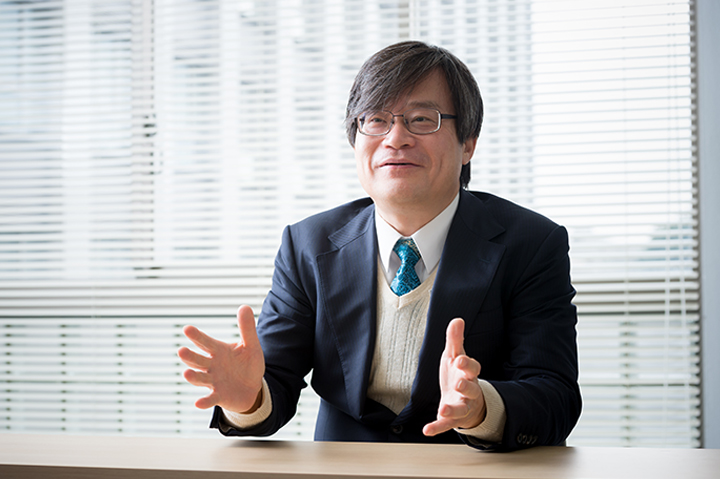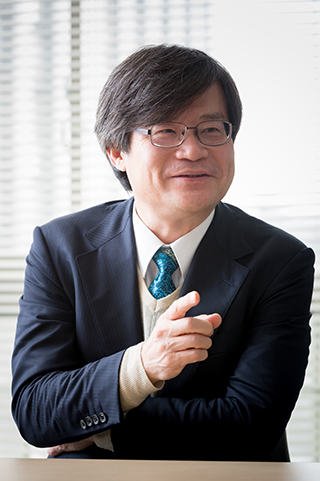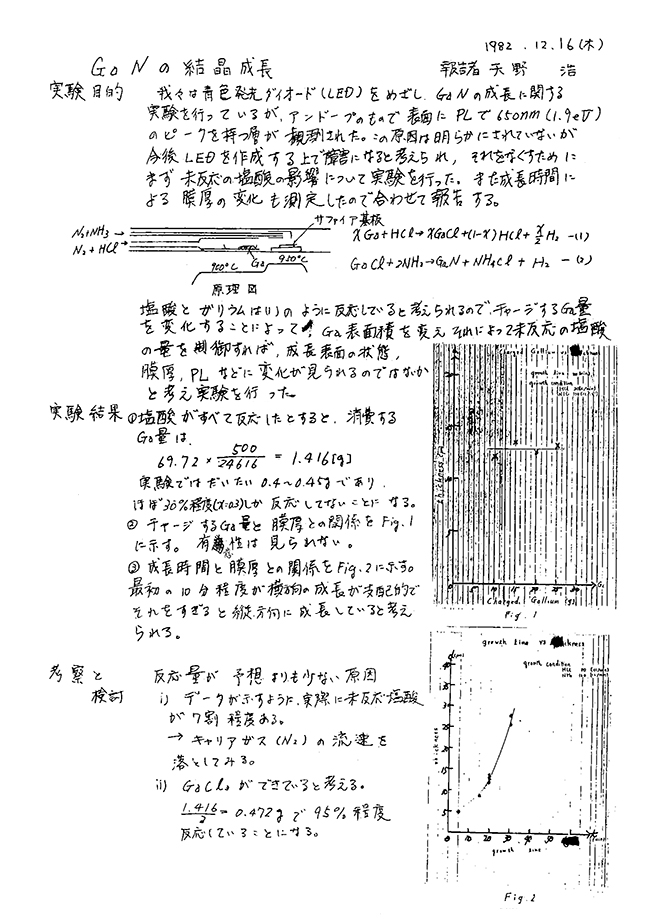- Home
- > Outreach
- > Publications
- > CONVERGENCE
- > LEADER’S VOICE
 LEADER’S VOICE
LEADER’S VOICE
A Conversation with Prof. Hiroshi Amano
Developing countries have more research seeds to sow.

Applied research beyond LEDs
— After winning the Nobel Prize, has your research in blue LEDs had new developments?
Yes. The fact that LEDs have become popular in general society means that its manufacturing technology has been established to some extent. Thanks to that, I think that we're now at the stage where various applications of LEDs can be considered; we're currently thinking about how to apply it to power devices in our laboratory, especially wirelessly. Gallium nitride has a very large bandgap, that is, it has high dielectric breakdown tolerance. That makes it possible to make small devices. The fact that it can be made smaller means less energy loss. I think that we're at the point where if we press on a little more, we'll see it in practical use. I believe that if wireless power transmission is realized, the world will change dramatically. Drones, for example; it can only fly for about 30 minutes at the most due to limits in battery capacity, but if we develop wireless power supply technology, longer flight periods will be possible. It's possible to revolutionize the physical distribution system centered on short distance transportation.
— Wireless power transmission technology is a very practical technology, but your career started with fundamental material research. What do you think of the relationship between basic research and applied research?
That's an important question. Using LED technology as an example, the required specifications for material reliability are entirely different in the case of LEDs and power supply circuits. LEDs as a light source will still glow without issue even with crystal defects. In extreme cases, traffic lights function as a signal light even if one of the LEDs used is not lighting up; however, this is not the case with power supply circuits. An electric car going out of control would be a dire situation. In other words, crystal defects can not be allowed. Fundamental science and basic research such as crystal growth technology, thermodynamics, statistics, and quantum mechanics are essential for establishing manufacturing technology that meets required specifications. Applied technology and the foundation are linked as one.
Yes. The fact that LEDs have become popular in general society means that its manufacturing technology has been established to some extent. Thanks to that, I think that we're now at the stage where various applications of LEDs can be considered; we're currently thinking about how to apply it to power devices in our laboratory, especially wirelessly. Gallium nitride has a very large bandgap, that is, it has high dielectric breakdown tolerance. That makes it possible to make small devices. The fact that it can be made smaller means less energy loss. I think that we're at the point where if we press on a little more, we'll see it in practical use. I believe that if wireless power transmission is realized, the world will change dramatically. Drones, for example; it can only fly for about 30 minutes at the most due to limits in battery capacity, but if we develop wireless power supply technology, longer flight periods will be possible. It's possible to revolutionize the physical distribution system centered on short distance transportation.
— Wireless power transmission technology is a very practical technology, but your career started with fundamental material research. What do you think of the relationship between basic research and applied research?
That's an important question. Using LED technology as an example, the required specifications for material reliability are entirely different in the case of LEDs and power supply circuits. LEDs as a light source will still glow without issue even with crystal defects. In extreme cases, traffic lights function as a signal light even if one of the LEDs used is not lighting up; however, this is not the case with power supply circuits. An electric car going out of control would be a dire situation. In other words, crystal defects can not be allowed. Fundamental science and basic research such as crystal growth technology, thermodynamics, statistics, and quantum mechanics are essential for establishing manufacturing technology that meets required specifications. Applied technology and the foundation are linked as one.
Stay hungry, young researchers!
— Do you have any thoughts on the state of Japan's research in comparison to the rest of the world?
After receiving the Nobel prize, opportunities to go abroad increased, bringing new discoveries. For example, I went to Silicon Valley, where their development is largely supported by AI and the Internet. Their efforts are all put into applied technology research rather than basic research, with seemingly no next step. In France on the other hand, each student is given experimental equipment devised to do basic experiments. Witnessing this hands-on approach, I truly felt that Japan doesn't match up. From my own experience however, I feel that students will be satisfied doing experiments as such. As a reaction to being unable to do experiments much upon entering college, I became absorbed in them for my graduation research, though the experiments did not go well at all. I think that my hunger for research was fostered by that reaction.
— Should students pursue experiences to study abroad?
I think so. Everyone wanted to study abroad in the United States and Europe in the past, but it seems that students nowadays don't want to go anywhere. I would encourage people to go to so-called developing countries.
— What do you mean by that?
Recently, I went to Oman and India. While the culture is wonderful, there are still a lot of unresolved social problems. Researchers can see that and realize the possibilities that their work has for society. I think it is very important for young people to have such experiences. In other words, I want them to think "I want to do this, I want to change society", I want them to have that hunger. You should be aware of social issues even if you're in Japan, but that is, in fact, difficult.
For example, Guatemala is struggling to secure water. Domestic wastewater has entered the lakes where water is collected from, causing health problems. We need to clean up the water there, but since hearing that it's technically difficult I've begun looking towards cooperative efforts. We're working on ultraviolet LEDs in our laboratory, and since we've made advancements in collaborative research with enterprises on water purification, we've been able to provide informational support. Ultraviolet equipment isn't suited for large-scale purification however, so we received help from a Nagoya University professor who is researching microbe use for clean water. With this, we were able to start the project.
There are many cases where research themes can be found by focusing on the present state of developing countries, rather than watching only developed countries where cutting-edge research is happening. I think that being aware of it while young, and having a sense of purpose in my research is very important.
— You seem to be conscious of research that's useful for society. Do you always try not to lose your viewpoint as a researcher even in everyday life?
Research is on my mind on a daily basis, but since it makes up a large part of my life I don't see it as work. Just thinking about things to research is fun. Especially when going abroad and noticing problems you hadn't noticed before, it's fun to think about how you can solve it.
After receiving the Nobel prize, opportunities to go abroad increased, bringing new discoveries. For example, I went to Silicon Valley, where their development is largely supported by AI and the Internet. Their efforts are all put into applied technology research rather than basic research, with seemingly no next step. In France on the other hand, each student is given experimental equipment devised to do basic experiments. Witnessing this hands-on approach, I truly felt that Japan doesn't match up. From my own experience however, I feel that students will be satisfied doing experiments as such. As a reaction to being unable to do experiments much upon entering college, I became absorbed in them for my graduation research, though the experiments did not go well at all. I think that my hunger for research was fostered by that reaction.
— Should students pursue experiences to study abroad?
I think so. Everyone wanted to study abroad in the United States and Europe in the past, but it seems that students nowadays don't want to go anywhere. I would encourage people to go to so-called developing countries.
— What do you mean by that?
Recently, I went to Oman and India. While the culture is wonderful, there are still a lot of unresolved social problems. Researchers can see that and realize the possibilities that their work has for society. I think it is very important for young people to have such experiences. In other words, I want them to think "I want to do this, I want to change society", I want them to have that hunger. You should be aware of social issues even if you're in Japan, but that is, in fact, difficult.
For example, Guatemala is struggling to secure water. Domestic wastewater has entered the lakes where water is collected from, causing health problems. We need to clean up the water there, but since hearing that it's technically difficult I've begun looking towards cooperative efforts. We're working on ultraviolet LEDs in our laboratory, and since we've made advancements in collaborative research with enterprises on water purification, we've been able to provide informational support. Ultraviolet equipment isn't suited for large-scale purification however, so we received help from a Nagoya University professor who is researching microbe use for clean water. With this, we were able to start the project.
There are many cases where research themes can be found by focusing on the present state of developing countries, rather than watching only developed countries where cutting-edge research is happening. I think that being aware of it while young, and having a sense of purpose in my research is very important.
— You seem to be conscious of research that's useful for society. Do you always try not to lose your viewpoint as a researcher even in everyday life?
Research is on my mind on a daily basis, but since it makes up a large part of my life I don't see it as work. Just thinking about things to research is fun. Especially when going abroad and noticing problems you hadn't noticed before, it's fun to think about how you can solve it.
Research that births 1 from 0 & Research that develops 1 into 10

— By the way, you're working on collaborative research with Director Koide of NIMS. How did that come together?
We researched together at the Akasaki laboratory, and as my senior we get along great, so that's one reason. Another is that NIMS has the world's best physical property evaluation ability, which was necessary for our research. For example, if you want to investigate the structure of killer defects in gallium nitride crystals, NIMS is the only research institution that can evaluate at the atomic level. Thanks to the collaborative research, I gained a deeper understanding of several things in a short time. I think NIMS's ability in such basic fields is truly wonderful.
— WPI-MANA advocates a new paradigm called "nanoarchitectonics" to promote nanotechnology research. Do you have any advice for the next steps in "nanoarchitectonics"?
I think what is expected of NIMS and WPI-MANA by society is that we will produce a lot of excellent fundamental research results, and I would like to continue to meet those expectations in the future. However, in Japan there are many researchers who are now working to create 1 from 0. To that end, the job of developing 1 to 10 is starting to be more significant. What do we do with that? If we smoothly coordinate research results, which is stage one, as specialists making new things start appearing, I think that it will be possible to secure a connection with the real world. It may be necessary to have work linking the invention to the innovation.
— Can young people fulfill that role?
Rather, I think that young people are more qualified. Even if we come up with new ideas at our age, it's difficult to carry on immersed in our work. This is where youthful power and motivation are necessary.
We researched together at the Akasaki laboratory, and as my senior we get along great, so that's one reason. Another is that NIMS has the world's best physical property evaluation ability, which was necessary for our research. For example, if you want to investigate the structure of killer defects in gallium nitride crystals, NIMS is the only research institution that can evaluate at the atomic level. Thanks to the collaborative research, I gained a deeper understanding of several things in a short time. I think NIMS's ability in such basic fields is truly wonderful.
— WPI-MANA advocates a new paradigm called "nanoarchitectonics" to promote nanotechnology research. Do you have any advice for the next steps in "nanoarchitectonics"?
I think what is expected of NIMS and WPI-MANA by society is that we will produce a lot of excellent fundamental research results, and I would like to continue to meet those expectations in the future. However, in Japan there are many researchers who are now working to create 1 from 0. To that end, the job of developing 1 to 10 is starting to be more significant. What do we do with that? If we smoothly coordinate research results, which is stage one, as specialists making new things start appearing, I think that it will be possible to secure a connection with the real world. It may be necessary to have work linking the invention to the innovation.
— Can young people fulfill that role?
Rather, I think that young people are more qualified. Even if we come up with new ideas at our age, it's difficult to carry on immersed in our work. This is where youthful power and motivation are necessary.
The first page of the graduation research presentation materials

"Since the experiment did not work at all and a classmate reported on the most advanced research results at the time, my report was the only one without content. My regret now is my starting point. This report was the impetus for my immersion in experiments between my master's and doctoral courses."
Hiroshi Amano
Completed coursework without degree at Nagoya University Faculty of Engineering/Graduate School of Engineering in 1988, aide in Engineering Department the same year, Doctor of Engineering in 1989. Lecturer at Meijo University Faculty of Science and Technology in 1992, Associate Professor in 1998, Professor in 2002. Professor at Nagoya University Faculty of Engineering/Graduate School of Engineering since 2010. Has concurrently served as Director of Akasaki Research Center since 2011. Appointed Director of Center For Integrated Research of Future Electronics, Institute of Materials and Systems for Sustainability at Nagoya Universit y, October 2015.
Succeeded in inventing the world's first high-quality crystal cr eation technology for blue LEDs, along with tenured professor at Meijo University & distinguished professor at Nagoya University Isamu Akasaki and University of California Santa Barbara Professor Shuji Nakamura, earning the Nobel Prize in Physics, among many other awards.
Completed coursework without degree at Nagoya University Faculty of Engineering/Graduate School of Engineering in 1988, aide in Engineering Department the same year, Doctor of Engineering in 1989. Lecturer at Meijo University Faculty of Science and Technology in 1992, Associate Professor in 1998, Professor in 2002. Professor at Nagoya University Faculty of Engineering/Graduate School of Engineering since 2010. Has concurrently served as Director of Akasaki Research Center since 2011. Appointed Director of Center For Integrated Research of Future Electronics, Institute of Materials and Systems for Sustainability at Nagoya Universit y, October 2015.
Succeeded in inventing the world's first high-quality crystal cr eation technology for blue LEDs, along with tenured professor at Meijo University & distinguished professor at Nagoya University Isamu Akasaki and University of California Santa Barbara Professor Shuji Nakamura, earning the Nobel Prize in Physics, among many other awards.

